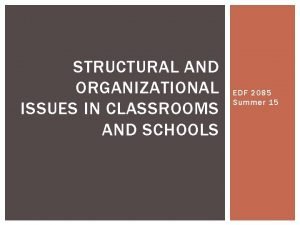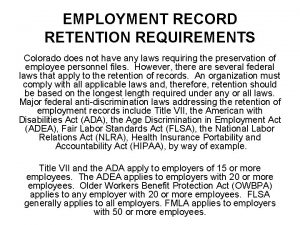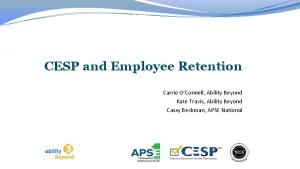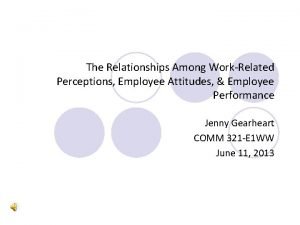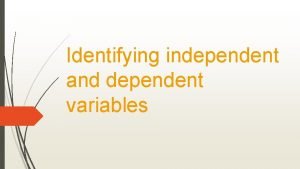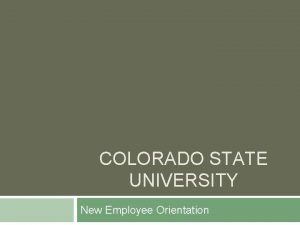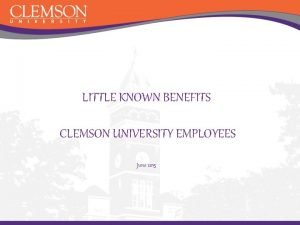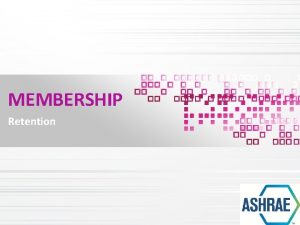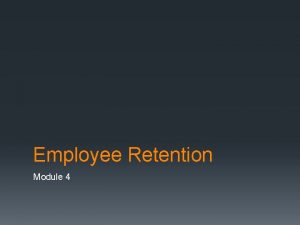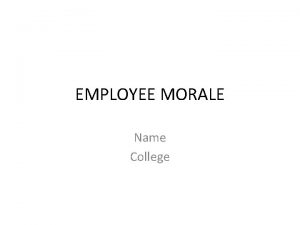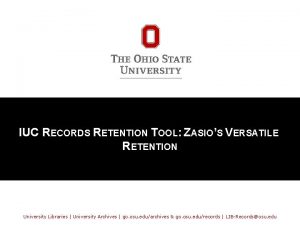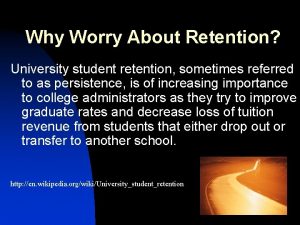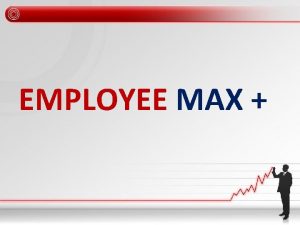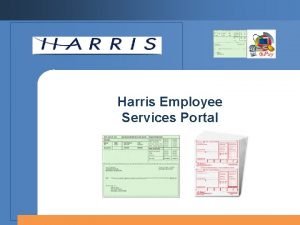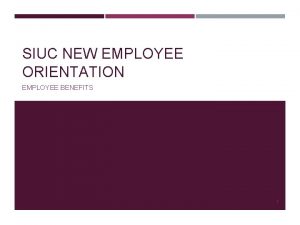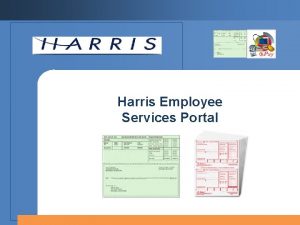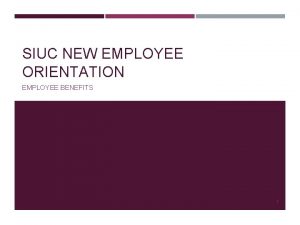Employee Retention Students Name University Introduction v Employee














- Slides: 14

Employee Retention Student’s Name University

Introduction v. Employee retention goes hand in hand with employee separation. Employee retention can be described as the process of maintaining workers with good and distinct skills. On the other hand, employee separation is the act of terminating employees appropriately, respectfully, and efficiently. v. The primary objective of employee retention is to minimize turnover; a company's Human Resource department normally carries out the process. v. Employee retention is essential for maintaining long-term staff, thereby ensuring less time for new employees' resources and training. It also instills loyalty from employees towards the organization. v. Employee retention is the key determinant of an organization's success or failure; the employees and skills kept in a company are the primary engines to its success.

Alignment of Employee Retention and Separation with HR Strategy v. The process of employee retention typically involves internal promotion opportunities, employee training, enhancement of workplace procedures and policies, and giving bonuses to outstanding employees. v. The entire retention and separation process is supervised by the HR department who is tasked with conducting, recommending, and implementing the recommended strategies as the company restructures (Bass et al. , 2018 ). v. The alignment of employee retention with the HR strategy is described under external and internal strategies. The external strategies include; Bargain Laborer (Cost) HR strategy, which involves a reduced emphasis on retaining high performers with minimal stress on sucking low performers. Free Agent (Differentiation) HR strategy, which involves a minimal focus on maintaining high performers and stresses on doing away with them.

Cont. ’ v. The internal description involves; loyal soldier (Cost) HR strategy, which focuses on maintaining high performers with a low emphasis on doing away with the poor performers. A committed expert (Differentiation) HR strategy that stresses on keeping excellent performers with an increased focus on dismissing poor performers. v. The Human Resource Management is responsible for keeping the competent and incompetent staff in an organization. It's the department's role to evaluate and analyze every employee's performance to ensure the right workforce and skill is available for the company's success. v. The Loyal soldier strategy ensures reduced expenses on the recruitment process providing employees with sufficient security enabling them to work for reduced salaries compared to the rival firms.

Cont. ’ v. A Committed Expert in HR enhances the structuring of an employee workforce with special skills to rival organizations. The subject skills are vital in producing quality and unique products and services incomparable or unduplicable by the competitors. v. A highly skilled workforce with exceptional knowledge and capabilities is the key to an organization's differential success (Kundu & Gahlawat 2016). v. Free Agent strategy comes with the benefits of replacing incompetent employees with skilled and innovative ones. Employee separation is a common process in this strategy with minimal disruptions from previous turnover processes.

Employee Turnover Process and its Reduction Methods v. Employee turnover can be described as the percentage of employees who leave an organization and be replaced by new employees. v. Employee turnover exists in two dimensions; voluntary and involuntary turnover. Voluntary turnover occurs when the employee gets to decides to quit his job, while involuntary turnover is where the company gets to terminate the employment contract. v. Employee turnover is divided into four; functional turnover occurs when poor-performing employees quit the company voluntarily. Functional retention is whereby excellent-performing employees retain their employment status. Dysfunctional turnover is whereby averageperforming employees quit their jobs. Dysfunctional retention is whereby poor-performing employees remain employed in the organization.

Cont. ’ v. Voluntary turnover is motivated by low job satisfaction. Job satisfaction is a key determinant of why an employee will decide whether to remain or quit in pursuit of a better job. v. Low job satisfaction leads to negative thoughts; hence the decision to quit; availability of alternative better jobs is also very influential. Employee dissatisfaction can be contributed by unsatisfying pay, empowerment, job fulfillment, work group, facilitation, and security. v. An organization can use various processes to reduce turnover; one is through the job description index. Description index is whereby the company conducts surveys on job satisfaction, thereby knowing the challenges facing its employees.

Cont. ’ v. Socialization is the second method; in this case, the company gets to avail the required knowledge and character suited to be its employee. The employee is told what is required of him/her hence capable of making their decisions appropriately. v. Perceived organizational turnover is the second method; this is employees' perception that the company cares about their well-being and recognizes their efforts to its success. Those who perceive support and care from the company will stick with the company. v. HR practices that can help reduce turnover rates include appropriate staffing, training and development, career planning, good labor relations, and compensations when necessary

Benefits and Problems from Employee Layoffs v. Layoffs can be described as the act of large-scale employee-contract termination disassociated to their work performance. Downsizing is whereby the company gets involved in extensive layoffs to reduce its workforce permanently. Layoffs result in uncertainty, worry, and financial challenges to the victims. v. The benefits of layoffs are; the company secures the best team for its errands. The subject act ensures the company stays competitive with minimal expenses on the labor force. v. The second benefit is that the remaining employees will be forced to improve performance-wise; anyone who is not above average will face the company's wrath if the message being conveyed. The third benefit is that it is e cost-effective process; an organization with financial challenges with uncertainties of getting revenue will embark on layoffs to save on expenses.

Cont. ’ v. The problems associated with layoffs include incorporating several legalities; layoffs may lead to woes and problems for the company if it is not handled appropriately. The second problem is that too much is added on the retained employees; a relative workforce increase is sequential to the remaining employees, leading to health complications or even performance reduction. v. The third problem is that it results in a decrease in employee morale; this applies to those whose close acquaintances have been dismissed, thereby leading to a feeling of insecurity. Job insecurity is the final problem; the retained employees might seek alternative jobs since they know its unstable condition. They will lose concentration on their jobs and re-direct it to seeking new jobs.

Methods of Employee Discipline and Due Process Principles v. Discipline can be described as a company’s management towards assisting their employees to overcome unwanted character-challenges within the workplace. v. Due process is defined as a set of protocols in line with an established set of rules and principles to enhance employee fair treatment. v. Progressive discipline is a process whereby severe and strict outcomes are successively given to employees with continuous unwanted characters. v. Methods used to implement progressive discipline involve; verbal warning; the manager/supervisor discusses the problem with the employee and highlights the effective consequences of failure. The second one is written writing; the reporting manager documents the subject problem and subsequent consequences of a repeat behavior (PHONE & DEEP 2019).

Cont. ’ v. The third method is suspension; the employee is prohibited from working for a given period without any pay. The fourth and final method is dismissal; the employer gets to terminate the employment relationships with the employee. v. Due process principles include; the right of employees to know the employer expectations and the subsequent consequences of failure to meet them. The second principle is that the company discipline is facts -based. v. The third principle is that the employees be allowed to table their opinion on the subject problem. The final principle is that any subsequent punishment should be consistent with the offense's nature.

Effective Methods of Employee Dismissal v. Employee dismissal is one of the most emotional and difficult tasks to carry out in an organization. To counter the emotional attachment to this process, some companies have resorted to offering outplacement services that provide the dismissed employees with a hand in job hunting. It may include resume writing, support groups, and practice interviewing. v. Methods involved in employee dismissal include; telling the employee of the company’s decision to dismiss him/her, organizing a brief meeting. The third one is allowing the victim employee to speak and maybe let out their emotions; the meeting should be summarized in writing, including severance compensation, benefits, and services that the employee will be awarded (Vivek & Satyanarayana 2016). v. The final method is having the security personnel on standby if the subject employee gets to express him/herself violently.

References Bass, J. M. , Sarah, B. , Razzak, M. A. , & Noll, J. (2018, May). Employee retention and turnover in global software development: Comparing in-house offshoring and offshore outsourcing. In 2018 IEEE/ACM 13 th International Conference on Global Software Engineering (ICGSE) (pp. 77 -86). IEEE. Kundu, S. C. , & Gahlawat, N. (2016). Effects of employee retention practices on perceived firm and innovation performance. International Journal of Innovation and Learning, 19(1), 25 -43. PHONE, A. C. H. C. , & DEEP, T. A. (2019). Managing Employee Retention and Separation. Human Resource Management, 236. Vivek, S. , & Satyanarayana Rao, A. V. (2016). A Study on Employee Retention in Private Sector Banks. ITIHAS-The Journal of Indian Management, 6(2).
 Students retention
Students retention Payroll retention rules in co
Payroll retention rules in co Separation management adalah
Separation management adalah Certified employee retention specialist
Certified employee retention specialist Name all rays
Name all rays Vicenta ybardolaza description
Vicenta ybardolaza description Employee attitudes and employee performance
Employee attitudes and employee performance Dependent variable
Dependent variable Matthias benzer
Matthias benzer Aristotle university of thessaloniki international students
Aristotle university of thessaloniki international students Pre university students age
Pre university students age Colorado state university employee benefits
Colorado state university employee benefits Clemson employee perks
Clemson employee perks Auburn university employee pharmacy
Auburn university employee pharmacy Arotc oregonstate
Arotc oregonstate
